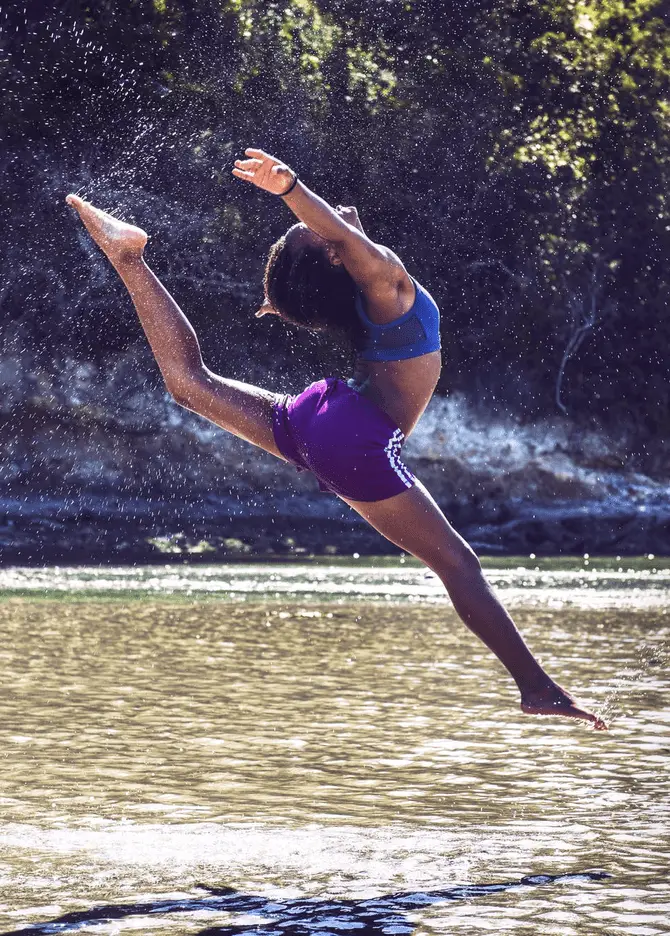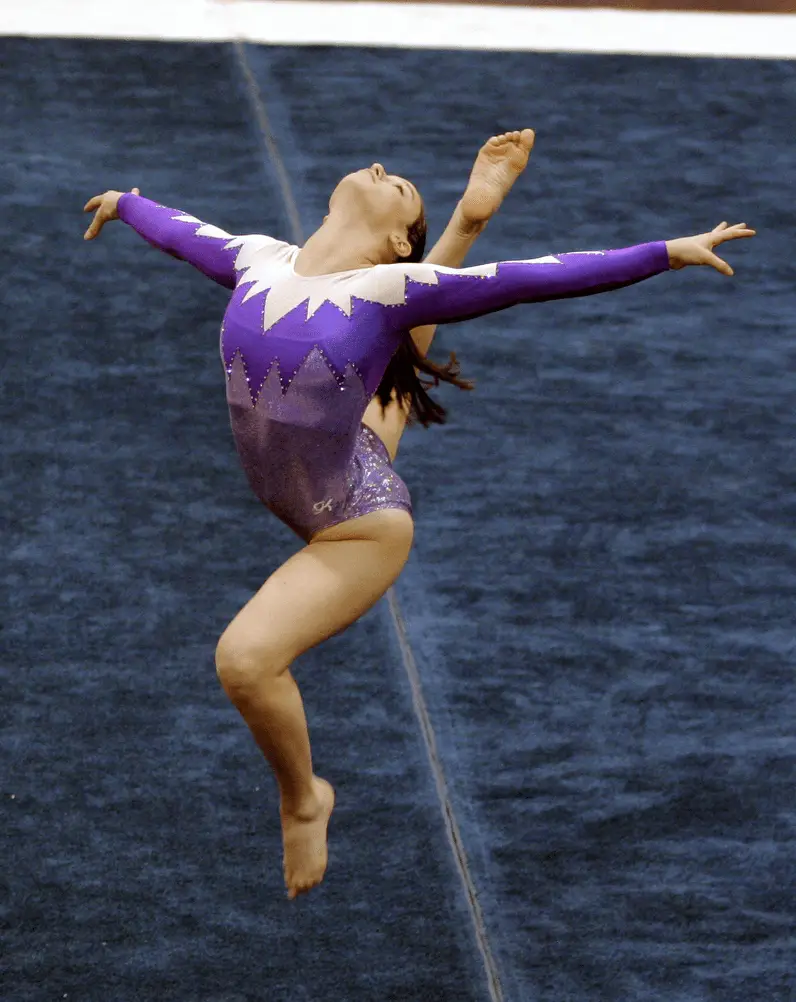Swimming is something that it is very fun to do, especially in the summer when it is quite a bit hot. Since gymnastics is also something that is done during the summer months, perhaps you are wondering if you can go straight to the pool after your class without having to change since gymnastics leotards do look quite a bit like swimsuits.
While, yes, you could wear a gymnastics leotard to the pool, there are a few reasons why you should probably just wear a swimsuit instead. While this is something that you can do in a pinch, however, as long as you take care of the leotard afterwards.
This is especially true if you are swimming for anything more then fun, since the swimsuit that you wear is something that can contribute to your performance in the water. If you are just wanting to have fun though, then this will not matter so much.

Some Of The Disadvantages Of Wearing A Leotard For Swimming
As mentioned, a leotard is not going to perform as well in the water. It will also be much harder to get out of when it is wet. Think for a moment on how hard it can sometimes be to get out of an actual swimsuit that is made with an open back to help with this most of the time.
A gymnastics leotard covers the back much more than a swimsuit is likely to, making it much harder to get out of for that reason alone. However, since gymnastics leotards are not made to get wet, these will have even less stretch when they are wet where a swimsuit is designed for you to be able to get out of it even when it is wet.

The next thing that you should be aware of is the fact that gymnastics leotards are not made to handle the chlorine and other chemicals that are found in a pool, nor should they even really be worn with the chemicals that are found in sunscreen.
These chemicals can literally ruin your leotard, bleach it, or affect it in a variety of ways that you do not want. Should you choose to wear you leotard anyway, you should at least rinse your leotard out as well as you can before washing it so that you can get as much of the pool out of it as possible.
For these same reasons, it is not quite so bad on your leotard if you were to wear it to the beach or lake, because the water does not have the chemicals. In the case of saltwater though, you should still give your leotard a good rinsing off as soon as you can.
In any case, since your gymnastics leotard is not made to get wet, it will tend to stretch out a little when it is used for swimming which will shorten its life considerably compared to how long it would last if it were used only for what it was intended to be.
One of the main differences between swimsuits and gymnastics leotards, besides the design, is the amount of padding that swimsuits have. These are made so that they do not reveal anything they are not supposed to even when you are wet.
Leotards are quite a bit thinner, and they have no such padding in them. This can also make them uncomfortable in the water as though you weren’t wearing anything at all. Also the sides of the pool as you get in and out will also be more likely scrape your skin through the leotard, not to mention damage the leotard itself.
Finally, one last thing is that there are a few different things that gymnastics fabrics can be made of, and each of these is different in the way it works – or doesn’t work – with water. There are six main things that gymnastics leotards are almost always made out of: nylon, spandex, lycra, stretch velvet fabric, mystique spandex, and drytech fabric.
Nylon Leotards
If you really want to wear a gymnastics leotard in the pool, nylon is probably going to be one that is best suited for this since some swimsuits are made out of nylon themselves. However, you should keep in mind that nylon is the generic name for a group of synthetic polymers and is entirely artificial, which means they have no basis in organic materials.
What all of this means that even though swimsuits can be made out of nylon too, it is a different type of nylon than the kind that is used to make leotards for gymnastics. Two fabrics can both be called nylon and still be quite different.
The pros of using nylon fabric:
- Strength –nylon has an excellent amount of abrasion resistance, so it is less likely to get damaged by anything that might be in the pool.
- Elasticity – thanks to nylon’s elasticity, it will be able to stretch and return to its original shape much better than some other fabrics, even if it gets a little stretched out due to being so wet.
- Absorbency – the low absorbency property of nylon makes it easy for water to run off the fabric and this also makes it dry quickly. However, in the case of using it for swimming this does give you a shorter window of time in which you need to rinse it out so that the chemicals from the pool do not dry into it.
- Wash-ability –nylon fabric is something that washes out fairly easily, meaning that the chemicals are less likely to damage the fabric permanently.
The cons of using nylon fabric:
- Effect of sunlight – nylon fabrics do not handle sunlight well, and this is even worse when they are simultaneously being soaked in things like chlorine.
- Weak resistance – this type of fabric does not have a very good resistance to things like mold, so it is very important to make sure that you don’t leave it in such a way that it will stay wet for a while. It also does not have a very good resistance to insects and fungi either.
- Deformability – nylon fabric will get that fuzz on it after a while and wearing the leotard swimming is something that will only make this worse.
Spandex Leotards
Spandex is a humanmade fabric with a significant amount of elasticity to it. The name spandex has been mistaken to be a brand name by several people in different situations. Spandex materials can stretch above five times its original, in part because of the fact that spandex fabrics are 100% synthetic fiber materials.
While these are not nearly as common as some of the other kinds of leotards, spandex is something that is seen fairly often. Most of the time, however, it is blended with other things so that you will very rarely see a leotard that is made 100% out of spandex.
The pros of using spandex fabric:
- Elasticity – as mentioned, spandex can stretch as far as 5 to 8 times its original size and also return to its original shape without damaging the structure of the fabric. A leotard should be able to stretch and return to its shape, which is one of the reasons the spandex fabric might be a good option for swimming.
- Offers support – leotards that are made from spandex fabrics have the ability to provide some additional support and these can help you keep your right form even if you are using it for swimming.
- Does not shrink – natural fiber cloths tend to shrink after washing, but spandex does a great job of being able to go through the wash without shrinking as long as it is on the cold cycle.
The cons of using spandex fabric:
- Harmful for the environment – one major disadvantage of the spandex fabrics is that they cannot be easily recycled, which ends up contributing to the world’s increasing level of solid waste and, in the long-run, impacts negatively on our environment.
- Cannot handle heat – due to the chemical composition of spandex, it can be susceptible to heat. Because of this, washing a spandex leotard in hot water or passing it through a drying machine or ironing it becomes disastrous. This alone makes care and maintenance of spandex fabrics difficult.
- Extra slippery – the smoothness of spandex fabrics makes them prone to slips on some specific apparatus and equipment even when used as leotards without being wet. Swimmers who perform activities that have a considerable risk of trips and fall should try as much as possible to avoid such leotards.
- Trap moisture – spandex leotards trap moisture and water because of its inability to allow the circulation of air, which makes it stay wet on you for longer and that it will take longer to dry when you get it home.
- Encourages yeast infections – because of the inability of spandex fabrics to allow the free flow and circulation of air, the use of a spandex leotard for swimming can have side effects. It can cause fungal or bacterial skin disorders and yeast infections due to keeping the moisture on you for so long.
Lycra Leotards
Lycra is a name for a highly elastic synthetic fabric, which is also sometimes known as elastane, and it is very similar to spandex. Lycra fabrics have an elasticity tolerance that can allow them to stretch as much as 5-8 times their usual size.
Lycra is composed of long chains of monomers that are specially connected with a type of unique acid and is highly resistant to heat. Just like spandex, lycra is also a full synthetic fiber, which means that all of its components are created in laboratory settings.
The pros of using lycra fabric:
- Elasticity – lycra has the ability to recover well even after when being stretched to above its original size. This is something that you would need a leotard to be able to do if you wanted to use it for swimming.
- Heat resistant – lycra also provides high resistivity to heat and its effects. It can stand a high level of hot temperature without losing its shape or deforming.
The cons of using lycra fabric:
- Can be stretched out – the elasticity tends to wear out with time. So swimming in it is only going to make this happen that much faster.
- Harmful for the environment – just like spandex, it harms the environment and it also contributes to solid waste due to its un-recyclable nature.
Stretch Velvet Leotards
Stretch velvet is a trendy fabric for the production of gymnastics leotards. This is actually made out of a blend of 90% polyester and 10% spandex. Stretch velvet is not as stretchy as some other obtainable fabrics but, even with that, many gymnasts love to use the stretch velvet because of the fact that the soft plush feeling of the fabrics is enough to make up for the loss of stretch.
For split styles gymnastics leotards, velvet is also used in conjunction with other fabrics as the solid color bottom. Velvet comes in varieties such as the crushed and flat kinds, with flat velvet coming with a more uniform look and feels, whereas the crushed variety has a patterned kind of look.
The pros of stretch velvet fabric:
- Soft feeling – the texture of this fabric is very soft, and it has a luxurious look. Even though this is a bit less noticeable when it is wet, stretch velvet can still have a little bit of a velvety feel to it.
- Good for the cold – stretch velvet fabrics are also an excellent preserver of heat. Its ability to keep the body warm makes it an excellent material if you plan on taking a swim during some of the cooler months when the water might be a bit cold.
The cons of stretch velvet fabric:
- Does not last long – this fabric wears out quickly, and swimming in it is something that will only shorten its life even more.
- Hard to clean – cleaning and maintenance can be challenging for this type of fabric. The utmost care must be taken to avoid damaging the fabric during the cleaning process.
- Easily damaged – stretch velvet leotards easily attract and accumulate dust and other things and because of the softness and luxurious looks of the fabric, any damage to the fabric will completely ruin the texture and, therefore, will ruin your leotard.
Mystique Spandex Leotards
Mystique fabric is a manmade fabric that is known for its sleek any shiny effect. This is that shiny fabric that leotards are fairly often made out of and it can be stunning when combined with motion and lighting effects.
Mystic spandex fabric is a perfect fit for gymnastics, dance, cheer, figure skating, costumes, and many more things, but swimming is not necessarily one of those things. The shiny foil finish can suffer damage due to exposure to sunscreens, chlorine, and saltwater.
The pros of mystique spandex fabric:
- Provides a good fit – mystique spandex is a good fit because of the fact that it does have excellent stretch capabilities .
- Looks nice – the beautiful fabrics make them look really nice as a swimsuit and it will usually keep its shine even when it is wet, and it is also easy to maintain and clean.
The cons of mystique spandex fabric:
- Loss of shine – leotards made from mystique spandex tend to lose their shiny coating with even ordinary use over time. This loss is sped up by exposure to sunscreen, chlorine, and saltwater.
- Easily damaged – due to their delicate nature of that shiny layer, any dent or damage can ruin the entire fabric. And also, when subjected to a hot water wash, the fabric can distort and become damaged.
Drytech Leotards
The drytech fabric is a blend of 92% polyester and 8% lycra. Thanks to this blend, it has a durable stretch characteristics and high resistance to ultraviolet light and bacteria effects. In addition, the drytech fabric has the capacity to not absorb humidity and to instead dissipate sweat.
With high strength and perfect resistance under any given conditions, D fabrics scale through the most stringent resistance tests in abrasion and wear and tear. Even after undergoing several machine wash, its original features like size, color, fabric quality will remain unaltered. The near-perfect bacterial control properties of the drytech fabric are actively responsible for the lack of bad odor formation caused by the bacteria which develop in the humid parts of clothes.
The pros of drytech fabric:
- It keeps you dry – the most obvious benefit of the leotards created from a drytech fabric is that it helps keeps you dry when you sweat by discharging the sweat as they form. While this is less useful if you are using this for swimming, it does mean than you are likely to dry off faster.
- Breathable – not only does the fabric design allow sweat to flow out, but it also has a good inflow of air to help improve the comfort and breathability. This helps prevent mold and other things that you don’t want.
- Easy to care for – drytech fabric comes with a stain-release property which means that this fabric requires less water and detergent when washing.
- Long life span – with the proper care drytech fabrics are known to last for a long period of time, if not years.
The cons of drytech fabric:
- Heavy – drytech fabric seems to be heavier than most of the other fabrics used for the production of leotards, and this will be even more true once it gets wet.
- Unhealthy for you and the environment – drytech fabrics or garments are usually coated with synthetic coatings, which have been linked to harmful toxins. Since this is a synthetic fabric, it also will not deteriorate once it has been thrown away.

